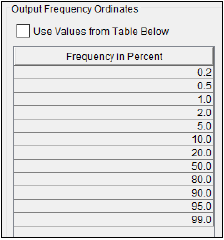Download PDF
Download page General Settings for Balanced Hydrograph Analysis.
General Settings for Balanced Hydrograph Analysis
Once the analysis name has been entered, the user can begin defining the analysis. Contained on the Balanced Hydrograph Analysis editor are three tabs. The tabs are labeled General, Frequency Curves, and Results. The first tab contains general settings for performing the balanced hydrograph analysis (Figure 1). These settings include:
- Output Labeling
- Number of Durations
- User-Specified Durations
- Time Window Modification
- Number of Probabilities
- User-Specified Probabilities for Balanced Hydrographs
- Output Frequency Ordinates
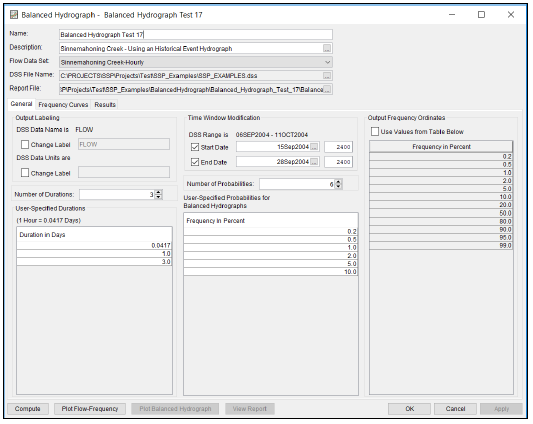
Output Labeling
This option, shown in Figure 2, allows the user to change the default labels for data contained in the output tables and plots. The user can change both the name of the data as well as the units of the data. The output labeling does not result in the conversion of data from one unit system to another; it only affects what is displayed on table headings and the y-axis of the results plot.
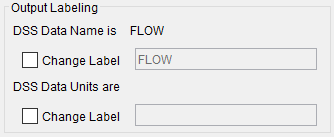
Number of Durations
This option allows the user to set the number of frequency curve durations that will be used to construct the balanced hydrographs, as shown in Figure 3. The number entered will modify the number of rows contained within the User-Specified Durations. Typically, balanced hydrographs are constructed using more than one duration. However, as the number of durations is increased, the resulting hydrographs will preserve less of the random character of natural hydrographs. At a minimum, the number of durations must be set equal to one.
![]()
User-Specified Durations
The User-Specified Durations table automatically adjusts the number of rows based on the defined number of durations. After the user sets the number of durations, the user must input the durations for which the balanced hydrographs will be created as shown in Figure 4. The program will arrange hydrograph ordinates to "balance" the flow-durations (i.e. volumes) using the durations defined within this table. Note that the units for each duration is days. For example, a one hour duration is equivalent to 0.0417 days.
There are no default durations. A typical listing of durations includes both shorter and longer durations. Durations should be listed in descending order with shorter durations listed first followed by longer durations. The smallest duration should be equal to or greater than the time step of the input flow data set. For example, a 1DAY flow data set cannot be used in conjunction with a specified duration of 0.0417 days.
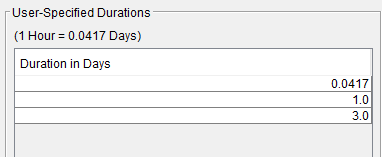
Time Window Modification
This option allows the user to define a time window used for the analysis as shown in Figure 5. The time window should correspond to the period within the Flow Data Set that the user wishes to use as a "template" hydrograph shape. The default is to use all of the data contained within the selected data set. If the default time window is used, HEC-SSP will identify the event with the greatest peak flow rate within the selected flow data set and use that as the "template" hydrograph shape. If a start and/or end date are used, they must be dates that are contained within the data stored in the selected data set. The date range for the selected data set is shown in the editor just above the Start Date field. Finally, if missing values are found within the Flow Data Set between the start/end date, an error message will be shown informing the user than either the time window needs to be changed or the missing values must be estimated.
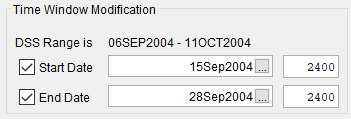
Number of Probabilities
This option lets the user choose the number of probabilities that will be used to construct the balanced hydrographs (Figure 6). The default setting is "1" probability. Using the default will result in the creation of a single balanced hydrograph.
![]()
User-Specified Probabilities for Balanced Hydrographs
The User-Specified Probabilities table automatically adjusts the number of rows based on the defined number of probabilities. After the user sets the number of probabilities, the user must input the probabilities for the balanced hydrograph analysis, as shown in Figure 7. This listing should be entered in ascending order (i.e. 0.2, 0.5, 1.0, etc). The input listing cannot use frequencies outside of the Output Frequency Ordinates. The input frequencies should have units of percent.
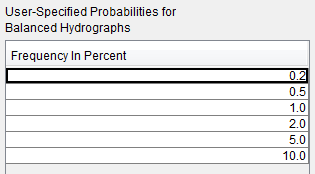
Output Frequency Ordinates
This option allows the user to change or add to the frequency ordinates for which the resulting frequency curve and confidence limits are computed, as shown in Figure 8. The default values listed in percent chance exceedance are 0.2, 0.5, 1, 2, 5, 10, 20, 50, 80, 90, 95, and 99. Check the box next to Use Values from Table below to change or add additional values. Once this box is checked, the user can add/remove rows and edit the frequency values. To add or remove a row from the table, select the row(s), place the mouse over the highlighted row(s) and click the right mouse button. The shortcut menu contains options to Insert Row(s), Append a Row, and Delete Row(s). The program will use the default values, even if they are not contained in the table, when the Use Values from Table below option is not checked. Finally, all values in the table must be between 0 and 100. Note that these values have no impact on the computed results, but rather only the values of the frequency curves that are used within the balanced hydrograph analysis.
